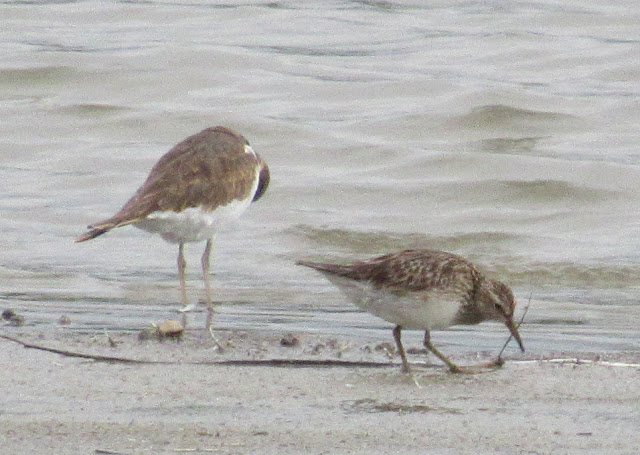Over the course of the last month, I've spent a bit of time at the abandoned beach in Springfield, Illinois. The site of an unfortunate drowning back in 2007, the beach has been closed since, fenced off and left alone. The only decent-sized wild beach or lake mudflat viewable by the public in Sangamon County, the Lake Springfield Beach is one of the best birdwatching locations in the county. Just ask these Pied-billed Grebes (Podilymbus podiceps):
These little grebes are just starting to appear on the lake, especially as people put away their boats for the year. Pied-billed Grebes dislike the frequent boat traffic of Lake Springfield in the summer months, and thus live and breed on quieter waters. However, they pass this way in the fall as they migrate southwards, and we're all the better for it.
Also, as I've mentioned previously, we've had a flock of Caspian Terns (Hydroprogne caspia) continuously on the lake since July 14. This is the longest a group of Caspian Terns has been seen on Lake Springfield, at least according to the limited information I've obtained online. There were well over a hundred back at their peak in late August, and they can be seen fishing all over the lake:
This beach is also the county's most consistent spot for sandpipers, including this little mystery:
I initially called this a Ruddy Turnstone, as one had been "sighted" earlier in the day here. However, upon further consideration and especially examination of the bill, this cannot be a Ruddy Turnstone in the slightest. I don't know what it is, so I would like some help in identifying it:
The dark collar appears a bit washed-out in these photos, but it was the most prominent feature of this unusual sandpiper. The bird, whatever it was, wasn't particularly shy. I was evidently the last to see it, as no one else reported this bird in any of the trips afterwards. As this was a few days ago, I don't know if we'll ever get a chance to see it again. (Note: Thanks to the half-dozen people who told me this was a Pectoral Sandpiper (Calidris melanotos))
Above, you can see it in comparison to a Killdeer twice. Below is my best shot of the bird:
Also, there's no chance that the birds below are Western Sandpipers? I might have to change an Ebird checklist and add a check to the list in the back of my Peterson if they are. Westerns would be new for the area, and rarely recorded in this county. (Note, Thanks for telling me that these ARE Least Sandpipers, and how to differentiate the two.)
In other birds seen here, a Great Egret (Ardea alba) has been intermittently seen since July. While obviously not a rare bird, I still enjoy seeing them, and they seem abundant this year.
The Double-crested Cormorants (Phalacrocorax auritus) have returned to Lake Springfield's three largest islands, where dozens roost every night. They can be seen fishing off the beach and nearby Marina Point. I keep hoping for a Neotropic Cormorant, but I doubt that'll happen this year.
One of the highlights I had here recently, which I would like confirmed by any birders familiar with the species, was a pair of probable Black Terns (Chlidonias niger), on the same day as the improbable Ruddy Turnstone. One of these is photographed below, although as a flyover it's not the best picture:
The fourth species of tern spotted were Common Terns (Sterna hirundo), distinguishable from the Forster's quite easily at this time of year, and quite obviously not Caspian Terns:
Also, on this same day again, September 7, 2016, Stilt Sandpipers (Calidris himantopus), appeared, in company of all the bird mentioned above. I rarely see them, so I was quite happy:
Sometimes, you're watching the birds, and sometimes they're watching you:
Only a few sandpipers, like the Killdeer (Charadrius vociferus) and the Spotted Sandpiper (Actitis macularius) below, are frequent flyers here, to use a pun that isn't used often enough, I feel.
Others, like this Solitary Sandpiper (Tringa solitaria), only come here for part of a day before flying off again. This habitat is simply not large enough to support medium/large sandpipers indefinitely.
Every so often, thankfully, we get a glut of Least and Semipalmated Sandpipers, two birds I can rarely if ever tell apart:
Of course, this whole happy business of sandpiper and tern watching will likely come to an end when they someday reopen the beach. Proposals have been swirling for the last several years, stalled by an economic downturn, though not for lack of interest. I've read recently that the beach will "Definitely" be opened next year for public business, so the birders may have to make do with other spots. Eh, we've had a good run, and it was always going to be temporary.
How many years before a lifeguard sits where this Great Blue Heron does now? God only knows.






















No comments:
Post a Comment